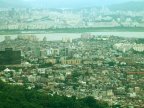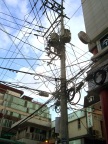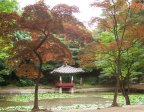People
|

|
 Children love to have their
pictures taken. Often they make a V sign--apparently it was at one time
supposed to mean "peace." On this day at Goereung Tomb I took eight
pictures of kids from one school group. Children love to have their
pictures taken. Often they make a V sign--apparently it was at one time
supposed to mean "peace." On this day at Goereung Tomb I took eight
pictures of kids from one school group.
 When you have a beard
and funny looking clothes, pretty girls come up and ask you to pose
with them for their camera. Here at King Munmu's Underwater Tomb
(upper-right corner) I made them take another shot with my camera. When you have a beard
and funny looking clothes, pretty girls come up and ask you to pose
with them for their camera. Here at King Munmu's Underwater Tomb
(upper-right corner) I made them take another shot with my camera.
|
 |
 |
 At Daehangno park while touring
the city we encountered a fascinatingly diverse bunch of people:
jugglers juggling, musicians playing, photographers shooting,
lovers meeting, drunks(?) sleeping, kids playing, and bemused adults
watching or just relaxing. At Daehangno park while touring
the city we encountered a fascinatingly diverse bunch of people:
jugglers juggling, musicians playing, photographers shooting,
lovers meeting, drunks(?) sleeping, kids playing, and bemused adults
watching or just relaxing.
 Here a family
visiting King Munmo's Tomb stopped to watch a pair of passing boats. Here a family
visiting King Munmo's Tomb stopped to watch a pair of passing boats.
|
 |

|
 This visitor seems perplexed by a
large finial for a roof beam. The finial is one from Anapji Pond, which
serendiptiously preserved many artifacts from its surrounding palace. This visitor seems perplexed by a
large finial for a roof beam. The finial is one from Anapji Pond, which
serendiptiously preserved many artifacts from its surrounding palace.
 At Seokguram Grotto
this gong is sounded at noon daily. It can be heard for miles. To sound
it, the monk does a little dance swinging it back and forth several
times before launching it at the bell with this final shove. At Seokguram Grotto
this gong is sounded at noon daily. It can be heard for miles. To sound
it, the monk does a little dance swinging it back and forth several
times before launching it at the bell with this final shove.
|
 |
| Homes |
 |
 Here in the "prosperous farmer's
house" at the Korean Folk Village the family is sitting down to dinner.
The room seems a little bigger than typical. Here in the "prosperous farmer's
house" at the Korean Folk Village the family is sitting down to dinner.
The room seems a little bigger than typical.
 An important part of
the cuisine
is kimchee, a spicy pickled cabbage. To get proper temperature and
humidity for pickling, fresh-made kimchee was buried in large pots
underground for a few months. Nowadays there are special refrigerators
for the task. An important part of
the cuisine
is kimchee, a spicy pickled cabbage. To get proper temperature and
humidity for pickling, fresh-made kimchee was buried in large pots
underground for a few months. Nowadays there are special refrigerators
for the task. |
 |
 |
 To enter our apartment you would
ring our doorbell, shown here. The big eye transmits a picture to us
before we push the button to unlock the door. (You would have first
rung us up from the main door and from the door to our corridor.) To enter our apartment you would
ring our doorbell, shown here. The big eye transmits a picture to us
before we push the button to unlock the door. (You would have first
rung us up from the main door and from the door to our corridor.)
 The "great room" in
our apartment combines kitchen, dining nook, living room, and den. We
had to turn the table 90º to its current position in order to be
able to open the refrigerator. The "great room" in
our apartment combines kitchen, dining nook, living room, and den. We
had to turn the table 90º to its current position in order to be
able to open the refrigerator.
|
 |
 |
 In one of the ubiquitous apartment
buildings (see below), the rooms are large, well-lit, and ultra modern.
Here is a kitchen. In one of the ubiquitous apartment
buildings (see below), the rooms are large, well-lit, and ultra modern.
Here is a kitchen.
 Korean meals have a
minimum of three "ban chan"--that is, small side dishes. Often they
come with tiny fish, seaweed, and various pickled victuals. Korean meals have a
minimum of three "ban chan"--that is, small side dishes. Often they
come with tiny fish, seaweed, and various pickled victuals.
|
 |
Shopping
|
 |
 Local markets cram a lot of things
into a small space. There are also huge supermarkets with many more
products. The latter also have numerous "hawkers" calling you to buy
their product and offering bits to taste. Local markets cram a lot of things
into a small space. There are also huge supermarkets with many more
products. The latter also have numerous "hawkers" calling you to buy
their product and offering bits to taste.
 The city is rife with
small shops offering all manner of wares. The city is rife with
small shops offering all manner of wares.
|
 |
 |
 In a "market" area, the small
shops are joined by numerous vendors on the sidewalk. And hundreds of
shoppers. In a "market" area, the small
shops are joined by numerous vendors on the sidewalk. And hundreds of
shoppers.
 In high-end
department stores, like Shinsegae seen here, the very latest in gear
can be bought. When I visited, however, the television department to
the right of this picture had more employees than customers. In high-end
department stores, like Shinsegae seen here, the very latest in gear
can be bought. When I visited, however, the television department to
the right of this picture had more employees than customers.
|
 |
Transportation
|
 |
 Subway stations are clean and
brightly lit. Most have been built in only the last decade or two.
Prominent in this photo are the gas masks available in case of fire or
terror attack. Subway stations are clean and
brightly lit. Most have been built in only the last decade or two.
Prominent in this photo are the gas masks available in case of fire or
terror attack.
 Signs in each subway
station tell you everything: where you are, next station in each
direction, times to each station, what's in the neighborhood, the
numbers for each pedestrian exit, and which way to go to transfer to
another line. The digital sign at the top shows advertising between
trains. As a train arrives at the previous station, a train icon crawls
from left to center of the sign. As the train proceeds onward to the
current station, the icon crawls to the right edge, reaching it as the
train whooshes in. Signs in each subway
station tell you everything: where you are, next station in each
direction, times to each station, what's in the neighborhood, the
numbers for each pedestrian exit, and which way to go to transfer to
another line. The digital sign at the top shows advertising between
trains. As a train arrives at the previous station, a train icon crawls
from left to center of the sign. As the train proceeds onward to the
current station, the icon crawls to the right edge, reaching it as the
train whooshes in.
|
 |
 |
 Horses used to be important. Now
they are relegated to shows at museums like the Korean Folk Village
outside Suwon. Horses used to be important. Now
they are relegated to shows at museums like the Korean Folk Village
outside Suwon.
 The intercity express
trains, "KTX," are luxurious and run at speeds well in excess of a
hundred miles an hour. We returned from this trip to Gyeongju an an
express bus that made no stops and thus reached Seoul faster even than
the train. The intercity express
trains, "KTX," are luxurious and run at speeds well in excess of a
hundred miles an hour. We returned from this trip to Gyeongju an an
express bus that made no stops and thus reached Seoul faster even than
the train.
|
 |
| Housing |
 |
 A gateway frames your first view
of the throne room at Chongdoek Palace. Just barely visible in the
courtyard are the numbered markers indicating the place to stand for
officials of the vaious ranks: 1, 2, 3, ... 16. A gateway frames your first view
of the throne room at Chongdoek Palace. Just barely visible in the
courtyard are the numbered markers indicating the place to stand for
officials of the vaious ranks: 1, 2, 3, ... 16.
 Old roofs are
universally built in this style: crests and valleys of tile laid on
rafters supported by beams. The ends of ascending beams are decorated
with round tiles painted with almost Amish designs. The orizontal beams
have the finial end caps. Old roofs are
universally built in this style: crests and valleys of tile laid on
rafters supported by beams. The ends of ascending beams are decorated
with round tiles painted with almost Amish designs. The orizontal beams
have the finial end caps.
|
 |
 |
 Many of the "edge-cap tile rows
(as at top center) are graced with monkeys and gargoyles. Many of the "edge-cap tile rows
(as at top center) are graced with monkeys and gargoyles.
 At the Folk Village,
some of the roofs have been allowed to develop their own eco-systems.
This building houses a modern day salesroom for craft-works. At the Folk Village,
some of the roofs have been allowed to develop their own eco-systems.
This building houses a modern day salesroom for craft-works. |
 |
 |
 "Ubiquitous apartment buildings."
Buildings of this same design are everywhere, even dotting the
country-side between cities. The apartments are elegant, huge, and
expensive. All three factors may help to avoid the sort of high-density
housing blight that led to the demolition of Chicago's Cabrini-Green. "Ubiquitous apartment buildings."
Buildings of this same design are everywhere, even dotting the
country-side between cities. The apartments are elegant, huge, and
expensive. All three factors may help to avoid the sort of high-density
housing blight that led to the demolition of Chicago's Cabrini-Green.
 Many farms are
covered to protect crops from sunlight and insects, thus increasing
value. It seems that all land is covered with either farms or
ubiquitous apartments. Many farms are
covered to protect crops from sunlight and insects, thus increasing
value. It seems that all land is covered with either farms or
ubiquitous apartments.
|
 |
 |
 Looking south from Seoul Tower one
sees old crowded housing on the
nearby hillside, office buildings, the Han river, and ubiquitous
apartments on the opposite shore. Looking south from Seoul Tower one
sees old crowded housing on the
nearby hillside, office buildings, the Han river, and ubiquitous
apartments on the opposite shore.
 On the (one!) sunny
afternoon I took this picture from my balcony. The
three close-by buildings are dormitories, as is our apartment. On the (one!) sunny
afternoon I took this picture from my balcony. The
three close-by buildings are dormitories, as is our apartment. |
 |
Museums
|
 |
 Despite the rain, I was able to
get some nice color in this shot of the
National Museum in Seoul. The huge poster announces a current exhibit
of artifacts on loan from a Pyongyang museum. Despite the rain, I was able to
get some nice color in this shot of the
National Museum in Seoul. The huge poster announces a current exhibit
of artifacts on loan from a Pyongyang museum.
 It seems to me that
the escalators in the National Museum make great pictures in themselves. It seems to me that
the escalators in the National Museum make great pictures in themselves.
|
 |
 |
 I couldn't get a decent picture of
the original of "Don Quixote" (National Treasure #91). So here is a
picture of the reproduction I bought. And even getting this picture
took 42 tries! I couldn't get a decent picture of
the original of "Don Quixote" (National Treasure #91). So here is a
picture of the reproduction I bought. And even getting this picture
took 42 tries!
 A metal dragon.
Probably an incense burner like Don Quixote. A metal dragon.
Probably an incense burner like Don Quixote.
|
 |
 |
 Almost a third my subjects at the
museum were pots. Here's the best, bedecked with little creatures. Almost a third my subjects at the
museum were pots. Here's the best, bedecked with little creatures.
 If you really want
eternal peace, why not get get buried in a pot. Pots are the
longest-lived artifacts of bygone civilizations. If you really want
eternal peace, why not get get buried in a pot. Pots are the
longest-lived artifacts of bygone civilizations.
|
 |
| Scenery |
 |
 This is one of a dozen "cave"
altars at Golgulsa. It's high on a hill, just beneath a five meter
Buddha carved into the living rock of the hill. This is one of a dozen "cave"
altars at Golgulsa. It's high on a hill, just beneath a five meter
Buddha carved into the living rock of the hill.
 Seoul Tower is
visible from most places in the city, including from the Traditional
Folk Village in a city park. This tree decorates one corner of the
village. Seoul Tower is
visible from most places in the city, including from the Traditional
Folk Village in a city park. This tree decorates one corner of the
village.
|
 |
 |
 South Korea is the third most
wired nation. A large fraction of households have broadband access to
the internet. One of the prices to pay is a lot of wires. South Korea is the third most
wired nation. A large fraction of households have broadband access to
the internet. One of the prices to pay is a lot of wires.
 Another lot of wire
guards the boundary to the North. Another lot of wire
guards the boundary to the North.
|
 |
 |
 Near to the DMZ, however, are
signs of hope. In the transit point for starting a tour of the DMZ,
someone has lofted this amzing string of kites. Near to the DMZ, however, are
signs of hope. In the transit point for starting a tour of the DMZ,
someone has lofted this amzing string of kites.
 The royals knew how
to have beauty at hand to escape reality. And now anyone with the price
of admission can visit to enjoy it, too. The royals knew how
to have beauty at hand to escape reality. And now anyone with the price
of admission can visit to enjoy it, too. |
 |
